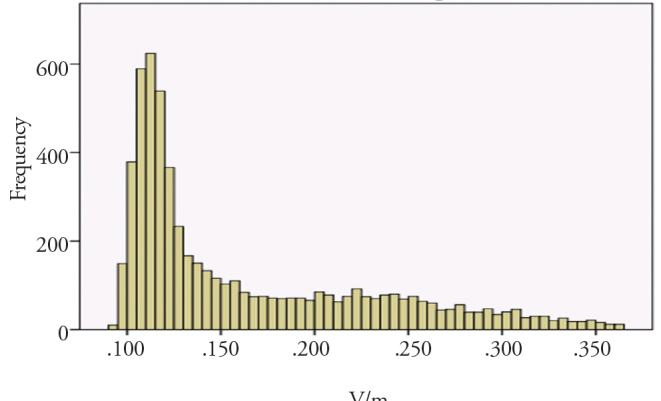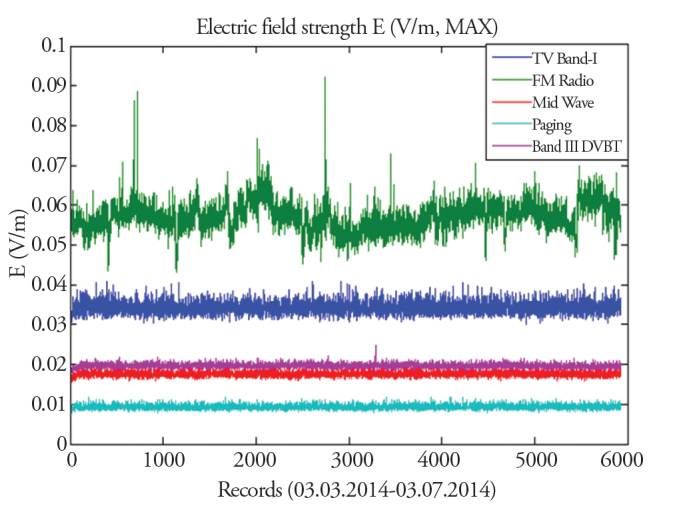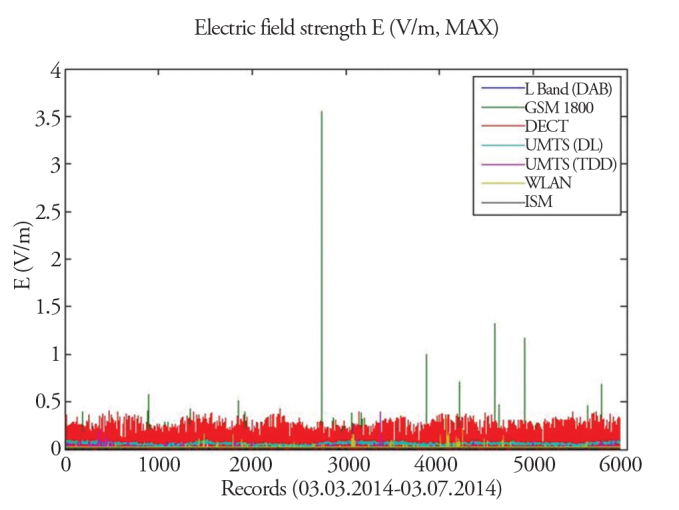Abstract
Objective
In this study, we conducted a numerical analysis of exposure to electromagnetic fields (EMFs) in a hospital’s intensive care unit that is one of the most crucial one in terms of hazardous areas among all service units. This is a new study for measuring exposure to EMFs in an intensive care unit as well as other healthcare services in Turkey.
Methods
We measured the EMFs in the intensive care unit with a SRM-3006 (selective radiation metre), which was used for measurement of the absolute and the limit values of high frequency EMFs. The measurement points were chosen to represent the highest levels of exposure to which a person might be subjected. We obtained a dataset that included 5929 observations, with 96 extreme values, through measuring the magnetic field in terms of V/m.
Results
The measurements show the frequency varies from 47 MHz to 2.5 GHz as 17 frequency ranges at the measurement point as well. According to these findings, the referenced maximum safety limit was not exceeded. However, it was also found that mobile telecommunication was the most critical cause of magnetic fields.
Conclusion
Further studies need to be performed with different frequency antennas to assess the EMFs in intensive care units.
Keywords: Electromagnetic fields, healthcare risk, safety, occupational, intensive care unit
Introduction
Nowadays, we live in the communication and information age. This has increased technological development and brings the point where the progress made in daily life as well as medicine science and intensive care science and work as suffering by the electromagnetic interference (EMI). In the 1990s, reports on the interference from EMI with intensive care devices started to emerge (1). Although nearly all electrical devices create electromagnetic radiation, mobile phones have received all of the attention. Other devices such as walkie-talkies, radios, Wi-Fi devices, personal digital devices and Bluetooth-enabled devices have various potential differences (1). With the early 1990s, the interaction between mobile phones and medical devices such as infusion pumps, infant incubator heaters, electrical chairs and ventilators were studied. At the same time, anomalous alarms have been observed. On the other hand, failures of ventilator function and interactions with pulse oximeters were rarely reported (2).
Electromagnetic interference is dependent on the devices’ features such as frequency, the physical relationship between devices (such as distance) and the affected device’s precision such as electromagnetic protectability or electromagnetic compatibility (EMC).
According to one study, it was determined that the electromagnetic field (EMF) of a device can result in inaccurate outputs, freezing of a data stream and harmful biological thermal effects to human and animal bodies (3).
As mobile phone usage has dramatically increased, the number and the complexity of intensive care unit (ICU) devices have also increased. In many researches that employ the effects of radio frequencies of Global System for Mobile Communications (GSM) reported that mechanical ventilators were variously affected in that 3 out of 22 stopped working especially for the near distance test (4).
Electromagnetic Environment Compatibility (EMEC) documents disclose the effects of EMFs on people where unwanted exposure can be called ‘electro-smog’. Besides, positive effects also exist such as stimulation therapy for getting over on human bodies. It is common sense that the closer to an EMF source one gets, such as a mobile device, the higher the risk for suffering health damage. The SMA Technical Information guideline (2015) gives us some recommendations about protecting against exposure of EMFs (5).
In this study, we aimed to obtain a numerical analysis of exposure to EMFs in the Dokuz Eylül University Hospital’s ICU in Turkey.
Methods
All measurements were performed with a SRM-3006 (selective radiation metre) that belonged to the İzmir Branch of Turkey’s Information and communication Technologies Authority (Dokuz Eylül University Department of Anesthesiology and Reanimation Intensive Care Unit). The study was conducted under ethical principles from the Declaration of Helsinki and national laws. The SRM-3006 portable selective device system was used to measure between 9 kHz to 6 GHz and was also used for safety analysis of high frequency EMFs. These frequencies are difficult to sample, so SRM-3006 uses both analog and digital signal processes. This device was also used for measurement of the absolute and the high frequency limit values of EMFs such as radio broadcasts (AM/FM), TV (analog, DVB-T), BOS (Tetra), mobile communication (GSM, UMTS), radar and wireless communication (WiMax, WLAN) (6). Device probe ‘Antenna Three-Axis E-field 27MHz-3GHz’ was used.
The measurement point was chosen to represent the highest levels of exposure to which a person might be subjected. The measurement was made for a single point, 1.5 m above floor level.
The sensor measured the data at the measuring point inside the ICU. All electromagnetic wave sources emit electromagnetic waves, and these waves were recorded individually in terms of V/m per minute for maximum and minimum value. The electric field is scalar, so electric field values that were emitted by electromagnetic wave sources became aggregated.
Electromagnetic fields can be sub-divided into two components: the electric field E (measured in V/m) and the magnetic field H (measured in A/m). The E-field and the H-field are mathematically interdependent in the far field. This means that only one component has to be measured. Only electric field strength is normally measured since measurements are typically made in the far field (2).
Statistical analysis
The average values of observed EMF data were calculated and a histogram of all data was prepared with the Statistical Package for the Social Sciences 22.0 (IBM SPSS Statistics, Armonk, NY, USA). Individual data from each resource on a time basis is plotted on a graph using MATLAB®.
Results
Aggregated values of electromagnetic wave sources are shown in Table 1. These values, which represent the arithmetic average values in a time interval, were obtained from Dokuz Eylül University Department of Anesthesiology and Reanimation ICU by continuous measurements over four days. These measurements show the frequency varies from 47 MHz to 2.5 GHz as 17 frequency ranges at the measurement point as well.
Table 1.
Aggregated values of electromagnetic wave sources
| Source | Fmin [Hz] | Fmax [Hz] | RBW [Hz] | Average Value [V/m] |
|---|---|---|---|---|
| TV Band I | 47000000 | 68000000 | 5000000 | 0.0479994 |
| FM-Radio | 87500000 | 108000000 | 200000 | 0.06617149 |
| Mid Wave | 137000000 | 165000000 | 3000000 | 0.02547527 |
| Paging | 165000000 | 174000000 | 2000000 | 0.01248569 |
| Band III (DVB-T) | 174000000 | 230000000 | 5000000 | 0.02870249 |
| Trains | 467450000 | 468300000 | 200000 | 0.002697696 |
| Band IV (DVB-T) | 470000000 | 790000000 | 10000000 | 0.03874143 |
| Band V (DAB) | 790000000 | 862000000 | 5000000 | 0.02183274 |
| GSM-R | 876000000 | 880000000 | 500000 | 0.003947205 |
| GSM 900 | 890000000 | 960000000 | 500000 | 0.067725 |
| L-Band (DAB) | 1452000000 | 1492000000 | 5000000 | 0.01027265 |
| GSM 1800 | 1710000000 | 1880000000 | 500000 | 0.02952452 |
| DECT | 1880000000 | 1900000000 | 3000000 | 0.01737379 |
| UMTS-TDD | 1900000000 | 2025000000 | 5000000 | 0.02550301 |
| UMTS DL | 2110000000 | 2170000000 | 5000000 | 0.06446186 |
| W-LAN | 2400000000 | 2483500000 | 20000000 | 0.03647824 |
| ISM | 2483500000 | 2500000000 | 3000000 | 0.01628353 |
| Total | 0.515676011 |
F: Frequency; RBW: Resolution Bandwidth; FM: Frequency Modulation; DVB-T: Digital Video Broadcasting- Terrestrial; DAB: Digital Audio Broadcasting; GSM-R: Global System for Mobile Communications–Railway; DECT: Digital Enhanced Cordless Telecommunications; UMTS: Universal Mobile Telecommunications System; TDD: time-division duplexing; W-LAN: wireless local area network; ISM: Industrial Scientific Medical band
In Table 1, these measurements, regardless of the direction of the antenna (i.e. isotropically), are shown. It is important to avoid errors because EMFs are spread over different directions.
In our dataset, there were also some extreme values based on the data central tendency and dispersion measures. The average and standard deviation of data can be utilized for marking extreme values in the data as outliers when outside of the interval of mean±3*standard deviation. According to these factors, the threshold was calculated to be 0.364 V/m. Therefore, we extracted that there were 96 extreme values among the 5929 data points. After eliminating these 96 extreme values, the remaining 5834 observations are presented in Figure 1 as a histogram. The Histogram shows that the dataset was right-skewed with a mean value of 0.163 and standard deviation of 0.066. The highest frequency in the histogram means that most of the electric field data values were observed at lowered rates.
Figure 1.

Histogram of all observations of electric field data excluding extreme values
Figure 2 shows the measured electric field strength for TV Band-I, FM Radio, Mid Wave, Paging and Band III DVBT. The electric field strength of these radio bands in the range of 47 to 230 MHz varied from 0.00682 to 0.09222 V/m. The reference safety limit of 61 V/m was not exceeded.
Figure 2.

Measured electric field strength recorded values for TV Band-I, FM Radio, Mid Wave, Paging and Band III DVBT
Figure 3 shows the measured electric field strength for L-Band (DAB), GSM 1800, DECT, UMTS-TDD, UMTS DL, W-LAN and ISM. The electric field strengths of these radio bands in the range of 1.452 to 2.5 GHz varied from 0.00578 to 3.548479 V/m. The reference safety limits of 114 V/m for L-Band (DAB), 124 V/m for GSM 1800, 130 V/m for DECT, 130.7 V/m for UMTS-TDD, 137 V/m for UMTS DL, 137 V/m for W-LAN and 137 V/m for ISM were not exceeded. According to the standard limits, the intensity of electric fields in intensive care rooms was not in the danger zone. However, in the light of EMC knowledge, any of the equipment that were not protected or made immune to these instant electric field levels may be influenced.
Figure 3.

Measured electric field strength recorded values for L-Band, GSM 1800, DECT, UMTS (DL), UMTS (TDD), WLAN and ISM
GSM: Global System for Mobile Communications; DECT: Digital Enhanced Cordless Telecommunications; UMTS: Universal Mobile Telecommunications System; TDD: time-division duplexing; W-LAN: wireless local area network; ISM: Industrial Scientific Medical band
The electric field strength of these radio bands varied from 0.001980277 to 3.548479 V/m. The reference safety limit minimum of 61 V/m and maximum of 137 V/m was not exceeded. The overall RF EMF electric field had an arithmetic mean of 0.11212 V/m. The highest values of RF EMFs were caused by GSM1800 telephone base-stations (maximum 3.5484 V/m). The general RF exposure level in the ICU from fixed RF sources, including LF/MF broadcast, VHF broadcast, UHF TV and telecommunications, was very low.
Discussion
Due to safety concerns over electromagnetic pollution, large numbers of radiation generating intensive care devices, the limited space of intensive care rooms, and the fragile nature of critical-care patient conditions, the electromagnetic environment in ICU rooms are probably among the most hazardous areas from the point of view of electromagnetic radiation.
According to the findings of this study, the EMF exposure levels do not exceed limits recommended by International Commission on Non-Ionizing Radiation Protection (ICNIRP) and the Turkish Information and Communication Technologies Authority. Measurements did not indicate that field levels were higher than standard imposed limits. The relevant European recommended exposure limit for the public is in the range of 28 V/m to 87 V/m (7, 8).
The exposure assessment of RF sources close to the human body needs dosimetric evaluation because of the complex RF EMF pattern near to RF devices. The most important device producing the highest exposure to RF in public areas are mobile phones. Other portable RF wireless devices’ exposures, which can be close to the body expose the individual, are quite lower than a mobile.
The majority of studies have concluded that mobile telecommunication (particularly the use of mobile and DECT/cordless phones) can be considered as the main contributor to personal RF exposure (9, 10).
On the other hand, the contribution of RF exposure from wireless telecommunication technology is continuously increasing; and nowadays, its contribution is greater than 65% of the total human EMF exposure (11). That is why measurements for ICU rooms should be continuously monitored and the protection of the patients and personnel working in the ICU should be considered.
Riminesi et al. (12) showed that magnetic flux values decrease as the distance between the source increases. They suggest that, at 20 cm away from the source, the values reach background levels. The investigators also discussed the possible effects of magnetic flux on melatonin and circadian rhythms. In recent studies, it has been shown that weak EMFs can disturb melatonin secretion and circadian rhythms (13, 14).
The equipment used in ICU rooms must have certification relating to EMC and EMI tests in order to protect the patients who need extra safety. Also, those areas should be shielded as much as possible against outside interference sources.
Conclusion
This study is important for attracting attention to magnetic field in the ICUs. The International Agency for Research on Cancer reported in 2001 that extremely low frequency magnetic fields could also cause cancer in humans according to the proof of the relationship between infant leukaemia and high-level magnetic fields (12).
Further studies need to be realized, for the assessment of electromagnetic radiation from different frequencies antennas, employing in electromagnetic interference problems.
Footnotes
Ethics Committee Approval: Authors declared that the research was conducted according to the principles of the World Medical Association Declaration of Helsinki “Ethical Principles for Medical Research Involving Human Subjects”, (amended in October 2013).
Informed Consent: In the study we didn’t use any data about the patients. We only measure the magnetic field in the intensive care unit. Therefore we didn’t get consent from the patients.
Peer-review: Externally peer-reviewed.
Author Contributions: Concept – N.G.; Design – N.G., K.A.T.; Supervision – N.G., A.Ö.; Resources – K.A.T., E.Ö., B.I.G; Materials – K.A.T., A.Ö.; Data Collection and/or Processing – S.E., N.G.; Analysis and/or Interpretation – S.E., N.G., E.Ö., B.I.G.; Literature Search – N.G., K.A.T., E.Ö.; Writing Manuscript – N.G., K.A.T., E.Ö.; Critical Review – N.G., S.E., A.Ö.; Other – N.G., E.Ö., B.I.G.
Conflict of Interest: No conflict of interest was declared by the authors.
Financial Disclosure: The authors declared that this study has received no financial support.
References
- 1.Lapinsky SE, Easty AC. Electromagnetic interference in critical care. J Crit Care. 2006;21:267–70. doi: 10.1016/j.jcrc.2006.03.010. http://dx.doi.org/10.1016/j.jcrc.2006.03.010. [DOI] [PubMed] [Google Scholar]
- 2.Barbaro V, Bartolini P, Donato A, Militello C, Altamura G, Ammirati F, et al. Do European GSM mobile cellular phones pose a potential risk to pacemaker patients? Pacing Clin Electrophysiol. 1995;18:1218–24. doi: 10.1111/j.1540-8159.1995.tb06961.x. [DOI] [PubMed] [Google Scholar]
- 3.Mild Hansson, Kjell ILO. Radiofrequency Fields and Microwaves; in 49. In: Knave Bengt., editor. Radiation, Non-Ionizing. International Labor Organization; Geneva: 2011. Encyclopedia of Occupational Health and Safety, Jeanne Mager Stellman, Editor-in-Chief. [Google Scholar]
- 4.Barbaro V, Bartolini P, Benassi M, Di Nallo AM, Reali L, Valsecchi S. Electromagnetic interference by GSM cellular phones and UHF radios with intensive-care and operating-room ventilators. Biomed Instrum Technol. 2000;34:361–9. [PubMed] [Google Scholar]
- 5.SMA Technical Information. Electromagnetic (Environmental) Compatibility Occurrence of electromagnetic fields. [Access date: 15.10.2015]. http://www.rpc.com.au/pdf/electromagnetic_interference.pdf.
- 6.Narda SRM Electromagnetic Field Measurement System (Selective and Broadband) [Access Date: 02.02.2015]. http://www.protel-elektronik.com/asp/product/507/NARDA-SRM-3006.
- 7.Exposure to electromagnetic fields, “Directive of the European Parliament and of the Council of 29th April 2004 on the minimum health and safety requirements regarding the exposure of workers to the risks arising from physical agents (electromagnetic fields)”. [Access date: 15.10.2015]. http://eur-lex.europa.eu/legal-content/EN/TXT/?uri=URISERV:c11150.
- 8.Yönetmeliği BTK. Başbakanlık Mevzuatı Geliştirme ve Yayın Genel Müdürlüğü. Apr 21, 2011. Elektronik Haberleşme Cihazlarından Kaynaklanan Elektromanyetik Alan Şiddetinin Uluslararası Standartlara Göre Maruziyet Limit Değerlerinin Belirlenmesi, Kontrolü ve Denetimi Hakkında Yönetmelik. [Google Scholar]
- 9.Rüdiger M, Maria F, Rodney C, Adele G, Kari J, Carmela M, et al. International Commission on Non-Ionizing Radiation Protection. ICNIRP Guidelines for Limiting Exposure to Electric Fields Induced by Movement of the Human Body in a Static Magnetic Field and by Time-Varying Magnetic Fields below 1 Hz. Health Physics. 2014;106:418–25. doi: 10.1097/HP.0b013e31829e5580. [DOI] [PubMed] [Google Scholar]
- 10.Salceanu A, Lunca E, Luca C, Ursache S. Monitoring the Electromagnetic Traffic in an Intensive Care Unit. 2014 International Conference and Exposition on Electrical and Power Engineering (EPE 2014); 16–18 October; Iasi, Romania. [Google Scholar]
- 11.Gajšek P, Ravazzani P, Wiart J, Grellier J, Samaras T, Thuróczy G. Electromagnetic field exposure assessment in Europe radiofrequency fields (10 MHz–6 GHz) J Expo Sci Environ Epidemiol. 2015;25:37–44. doi: 10.1038/jes.2013.40. http://dx.doi.org/10.1038/jes.2013.40. [DOI] [PubMed] [Google Scholar]
- 12.Riminesi C, Andreuccetti D, Fossi R, Pezzati M. ELF Magnetic Field Exposure in a Neonatal Intensive Care Unit. Bioelectromagnetics. 2004;25:481–91. doi: 10.1002/bem.20017. http://dx.doi.org/10.1002/bem.20017. [DOI] [PubMed] [Google Scholar]
- 13.Halgamuge MN. Critical time delay of the pineal melatonin rhythm in humans due to weak electromagnetic exposure. Indian J Biochem Biophys. 2013;50:259–65. [PubMed] [Google Scholar]
- 14.Manzella N, Bracci M, Ciarapica V, Staffolani S, Strafella E, Rapisarda V, et al. Circadian gene expression and extremely low-frequency magnetic fields: an in vitro study. Bioelectromagnetics. 2015;36:294–301. doi: 10.1002/bem.21915. http://dx.doi.org/10.1002/bem.21915. [DOI] [PubMed] [Google Scholar]


